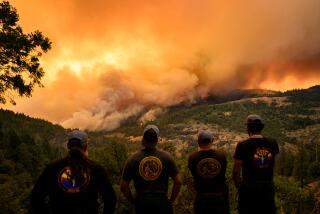Raining cats, dogs and frisky trout
Because I IMAGINE that my friend the stand-up comic has an evolved sense of humor, I take Chris Kuhn into fire-devastated Azusa Canyon.
Despite the sobering presence of burned-out cabins, it’s easy to forget that two seasons ago the flow among some pools of the West Fork of the San Gabriel River completely ceased, that the Curve Fire raced the length of the North Fork to Crystal Lake and beyond.
But it turns out that the North Fork is not a joke: On a 75-degree day around Christmas, knee-deep in water rushing past scorched granite, we pull out small rainbow trout.
As a freestone trout fanatic who routinely explores the Los Padres, San Gabriel and San Bernardino mountains, I’m always on storm watch.
Natural or imported from the Owens Valley, water makes magic, and we owe this outing in part to the recent impressive rains. In October the area recorded 4.5 inches, the most in that month since 1889. As the downpours continue into 2005, we’re well above normal for the rainfall season.
Fish in Southern California streams typically squeak by on 14 inches of precipitation a year. I’ve never seen a study, but the local trout probably qualify as North America’s most resilient, surviving the lowest waters and highest temperatures. Talk about oxygen deprivation. This season, though, they’re swimming under burbles of plenty of cold, clear water.
On my recent scouting missions into the mountains I’ve found stream-bred rainbows from 3 to 10 inches long in every nook of local creeks. They have been rising to flies, including attractor dries, or taking hare’s ear beadheads and mini woolly buggers subsurface.
For fly-fishers who are fascinated with aquatic entomology, the North Fork’s rocks tell the story. Kuhn and I spied small, dark mayfly nymphs skittering among the pebbly residences of caddis larvae, and one grapefruit-size rock, pulled from a riffle, displayed strong clusters of larvae, with a fine green Rhyacophila nymph worming about.
Kuhn tells me that he loves the small stream. I’m glad because that is my fly-fishing metier too. And he’s brought the right outfit, a St. Croix 6-foot three-weight fly rod ideal for tight quarters. I unsheath a Mike Clark bamboo.
I lend my guest a fly, he casts deftly and in a few minutes a rainbow rises to the #16 May Cad Stone as it dances on sparkling water. It’s a fish small enough to fit in one hand, but it’s a wild one, healthy and full of spit, taken and released back to the run where it hatched during a tough time. It is enough to make us smile.
The rains will make other outdoorspeople smile this year, too.
Bass anglers will appreciate lakes’ flooded shorelines, thick with submerged vegetation to investigate.
Spring wildflower fans will encounter a color explosion to rival 1999’s spectacular “Big Bang.” (Joshua Tree National Park received several inches of rain on top of a foot of snow before Thanksgiving.)
Next September, dove hunters will flush birds that have fattened all summer on an abundance of sprouts and seeds.
Fly-fishers will stalk more trout, as the state Department of Fish and Game typically plants more fish during wet, cold seasons.
Let it rain.
To read previous Fair Game columns, go to latimes.com
/outdoors.
More to Read
Sign up for The Wild
We’ll help you find the best places to hike, bike and run, as well as the perfect silent spots for meditation and yoga.
You may occasionally receive promotional content from the Los Angeles Times.






